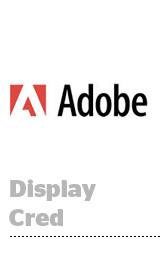 If Oracle will flaunt the tight integration of its Marketing Cloud, so too will Adobe. The company, at its Digital Marketing Summit EMEA in London Wednesday, revealed (among other Marketing Cloud enhancements) tighter integration between its Media Optimizer and Analytics applications. In so doing, Adobe seems to be in the early stages of positioning itself as a player in the display and social advertising space.
If Oracle will flaunt the tight integration of its Marketing Cloud, so too will Adobe. The company, at its Digital Marketing Summit EMEA in London Wednesday, revealed (among other Marketing Cloud enhancements) tighter integration between its Media Optimizer and Analytics applications. In so doing, Adobe seems to be in the early stages of positioning itself as a player in the display and social advertising space.
This would also explain why the company is emphasizing its partnerships with media sources like Turn, Pubmatic, Rubicon Project, FBX, Microsoft and Yahoo.
To be fair, these are not new partnerships, but Adobe is making a concerted effort to showcase them.
“People don’t understand Adobe is in the advertising business,” said Adobe’s director of product marketing Tim Waddell. “We need to make sure we’re in search, display and social business. We have one of the best optimization engines in the market.”
That optimization engine is Media Optimizer, which has 500 global customers and manages $2 billion in ad spend. Adobe is acutely aware that this application is commonly associated with managing search bids. “We are actively pursuing display and social business and we need to grow those channels,” Waddell said.
Though Adobe doesn’t have the reputation as a major player in display and social advertising, other industry insiders are aware of its potential to move heavily into that space. IgnitionOne CEO Will Margiloff recently told AdExchanger that Adobe has “bridged the gap between some paid stuff and some marketing automation, CRM-type things.”
In this regard, Adobe is certainly further along than its Marketing Cloud competitors like IBM, Oracle and Salesforce.com.
One of the key pieces for Adobe as it moves into display and social will be tighter integration with its vaunted Analytics product. It achieved a 16% lift of ROI in search campaigns by using Analytics to figure out what to do with keywords that didn’t lead to conversions. Basically, Adobe looked at activities on webpages – bounce rates, page views consumed and the like s – in order to better measure the value of a keyword.
While this process was relegated to search bids, Waddell emphasized that this modeling can be applied to display and social as well.
“We’re actively testing this in display and social,” he said. He doesn’t have a timeline as to when the results will be in.
Two other Marketing Cloud updates include: Live Stream, a “real-time event firehose” that enables clients to see what’s happening on the company website in realtime (this element isn’t new) and respond immediately (this element is); Analytics decision trees designed to predict the various pathways a website visitor might take.











